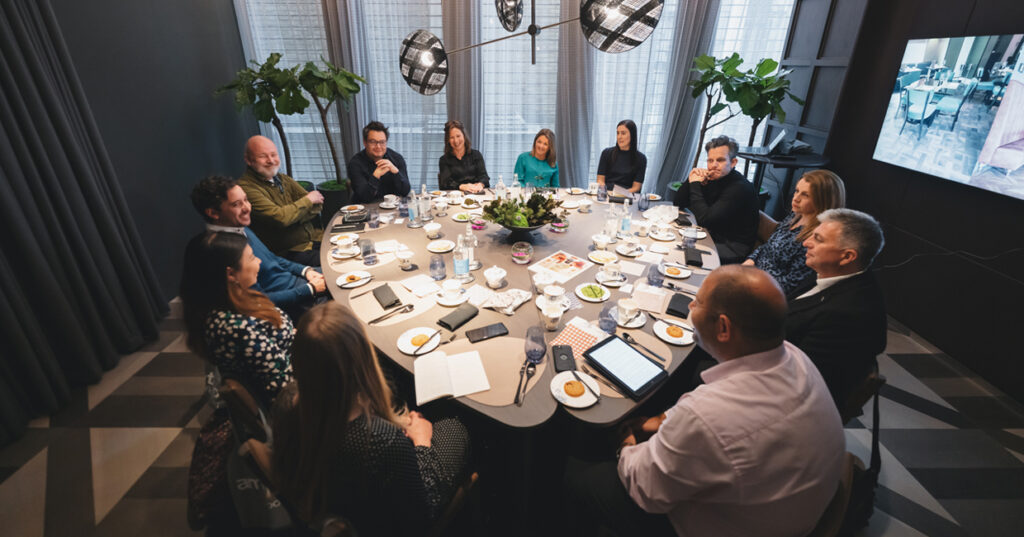September saw a diverse and talented group of designers come together at the newly opened Pan Pacific London, for a roundtable hosted by luxury flooring manufacturer, Amtico, and chaired by Hospitality Interiors’ Can Faik. The lively discussion spanned everything from post-Covid working practices and the impact of social media on design to the value of flooring as a wayfinding tool and sustainability. Gemma Lochhead reports …
The roundtable took place in one of Pan Pacific London’s elegant meeting rooms. Cutting a striking figure in the landmark tower at Liverpool Street’s One Bishopsgate Plaza, the hotel offers a tranquil sanctuary in the heart of the city. Yabu Pushelberg has artfully interwoven South-east Asian vibrancy with elements of traditional British design to create a distinct and compelling design narrative.
In attendance were: Alex Kravetz, principal and creative director, Alex Kravetz Design; Richard McCready-Hughes, creative director, Goddard Littlefair; Dennis Irvine, director, Richmond International; Ailsa Connery, design director, 1508 London; Sophia Wise, head of regional commercial, UK and Ireland, Amtico; Tom Thorogood, interior design associate, Dexter Moren Associates; Neil Andrew, head of hospitality, Perkins&Will; Joey Goei-Jones, design director, GDC Interiors; Sarah Thorpe, national hospitality manager, Amtico.
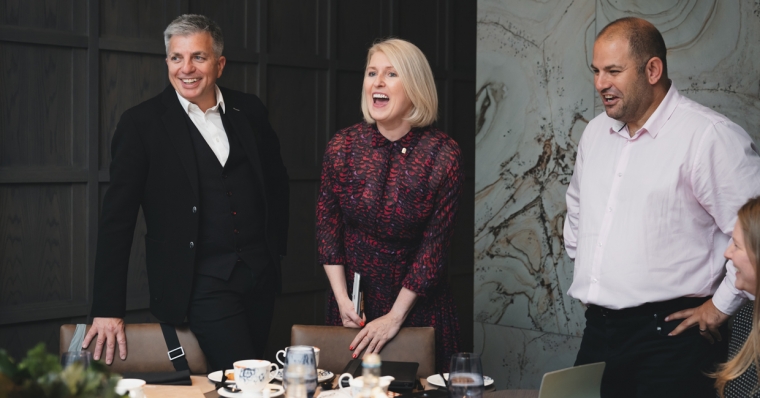
Post-Covid landscape
Naturally, the discussion began with an exploration of working practices in the wake of the Covid-19 pandemic. “What has been the biggest change in how you do your job, post-Covid?” Can put to the group.
“I think I speak on behalf of everyone when I say that it’s been an extremely difficult year,” answered Dennis Irvine. “Our industry is very tactile, you need to see things, touch things … it’s all very well having ‘Zooms’ and ‘Teams’ but I’m looking forward to travelling again and spending time with people.”
“I think last year we thought it would probably be temporary, and now we’re realising that this hybrid working is going to continue for the forseeable,” added Amtico’s Sarah Thorpe. “As a supplier we like to be able to show off our products face to face – we definitely get more collaboration if we’ve got the products in front of designers than if we’re doing Zooms or Teams. It’s a bit more of a challenge, but we’re finding our way around it.”
Ailsa Connery considered the disproportionate impact remote working has had on the industry’s more junior team members. “I do think it’s benefitted our more senior staff – they’ve enjoyed a much more flexible work/life balance,” she said. “Whereas I think our more junior staff have struggled, and I think it’s harder to manage them. They benefit so much from meeting suppliers, and getting to know these brands and understanding the whole process. When they’re not physically there they just don’t get that experience.”
“Our industry is very tactile, you need to see things, touch things … it’s all very well having ‘Zooms’ and ‘Teams’, but I’m looking forward to travelling again and spending time with people” – Dennis Irvine
Alongside the obvious challenges, Neil Andrew has found a closer connection with his team to be a silver lining. “The biggest thing for me from a manager’s point of view has been checking in with my team more,” he said. “I think since we became further apart we’ve become a bit closer together on a social level.”
For Richard McCready-Hughes, too, the pandemic has really put a premium on collaborative work in the studio. Time as a team is perhaps spent more productively, with an emphasis on exchanging ideas and information, while production work is completed at home. The loss of spontaneity in this regard, however, and the time spent orchestrating these discussions according to the demands of a project, are definite downsides.
For Alex Kravetz, on the other hand, the pandemic has affirmed the efficacy of pre-existing working practices. “We’ve always been an international team with people scattered all over the place, so for us we don’t really feel a lot of change, if any,” he said. “It’s a faster and more effective, more connective way of working. I think it’s a better way for us to move forward, plus it means a very tight team, and a very tight team of suppliers that work with us. Then, it’s orchestration that happens all the way through the day. Communication is the key.”
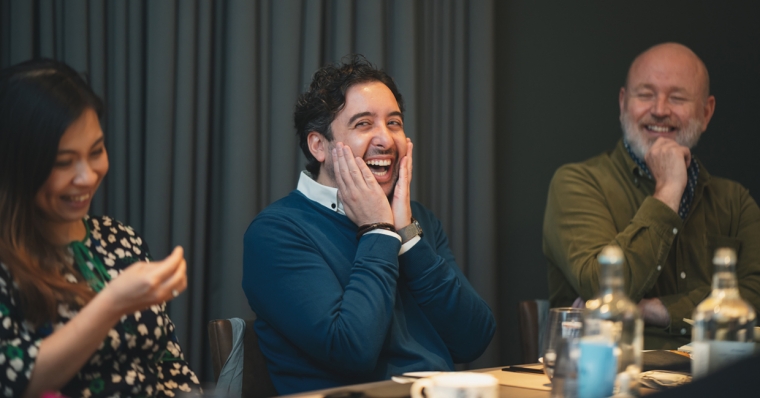
The role of flooring
Discussion turned to the impact of flooring within hospitality public spaces. “You have to think about it holistically,” said Tom Thorogood. “If you’re doing an external terrace, the flooring is key because there’s not much else going on – that is your key piece. Whereas in other spaces, if it’s not thought about, it will stick out in a bad way, and so you need to consider everything carefully.”
Sarah Thorpe reflected on the worth of bespoke flooring within hospitality schemes. “On the bespoke side, you can use colours and patterns tailored to your project requirements to make something a lot more individual. Certainly with LVT, you can just tell us what you want, and we can do it.”
Flooring was also a crucial component in the differentiation and wayfinding of hospitality spaces, the group felt. “I’m pretty sure everyone in this room over the last year would have found that, when you walked into a building, often the first thing you did is look down to see if there was a certain direction you needed to follow or a distance you had to keep from people,” said Sophia Wise. “We’ve seen that reflected in the projects that we do – it’s very much about wayfinding, and clients have been using flooring as a very subtle directional tool.”
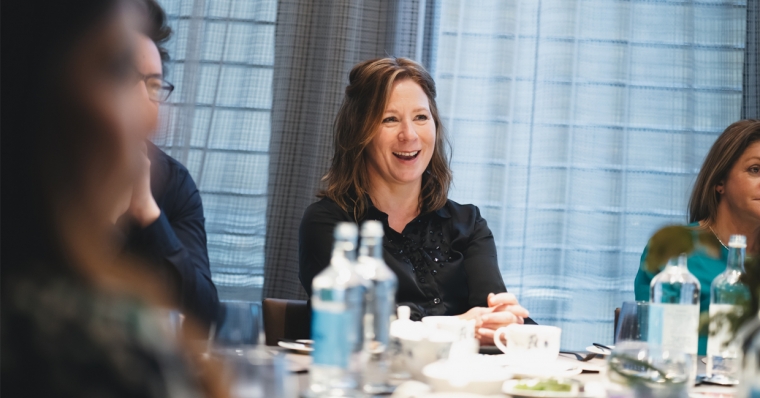
Social media
The impact of social media upon the hospitality industry is undeniable, but how do designers take this into account when designing a space? Can put this question to the group.
“It’s client driven,” responded Ailsa Connery. “At Jumeirah Carlton Tower there was originally a big column in the centre as you had that arrival moment, which has now been clad in mirrors so that it’s almost disappeared – that was one of the key changes in that project. They also host a lot of weddings, so when it came to the staircase they wanted something that felt grand to capture that moment when a bride is walking up the stairs. For some clients, it’s really about those beautiful photographic moments.”
Richard McCready-Hughes was in agreement, citing Goddard Littlefair’s recent work on Mayfair Townhouse as an example of an interior that lends itself to a more subtle approach to ‘Instagrammable moments’. “I agree entirely, it evolves naturally,” he said. “There are lots of little stories that are woven together within Mayfair Townhouse. Its higgledy piggedly layout, smaller and more intimate residential-scale spaces, and its dandy narrative means it has great intrinsic charm, I think. So, a lot of the Instagram moments came out of that, rather than being engineered as prime spots for Instagram points.
“If Mayfair Townhouse had been a different architectural animal we would have approached that completely differently. There would have been grand staircases if that’s what that space demanded.”
For Alex Kravetz, this subtle approach is certainly preferable and more effective. “I think when you approach things from a scenography point of view, that’s when organic Instagrammable moments will start to happen. And I think they have a more tangible affect on people’s emotions – rather than a generation of people who go to hotels, say they have been, but they actually haven’t spent a cent. They are not the guests you want.”
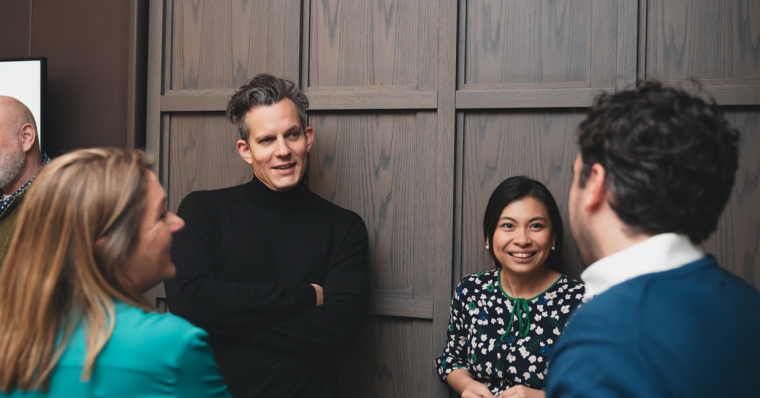
The power of designer/supplier relationships
Talk turned to the importance of strong relationships between designers and suppliers, and the overarching consensus amongst the group was that the working process and the end result are profoundly affected by these partnerships.
“I think it’s really important, because that ease of communication comes from familiarity, and sometimes when you know them not only in a work mode but beyond that, you feel more comfortable coming to them with a difficult question or request,” said Joey Goei-Jones.
“That’s probably why different firms have certain brands and groups that they go for – it’s because they’ve got that established relationship, and you can say to your client that they’ll definitely be taken good care of. Sometimes it’s that further reassurance you can give to the client – especially when owners are doing it themselves, as often they don’t know the different suppliers.”
“We won’t put anyone forward who we’re not confident can deliver the quality and dependability,” affirmed Dennis Irvine.
The specialist knowledge suppliers can contribute is vital, Richard McCready-Hughes suggested. “We’re very much ‘bringers together’ of lots of different elements – we can’t be experts in every single thing, so that technical expertise and craftsmanship we rely on other people for,” he said. “The better that dialogue is with those people, the better the end product is.”
“I think building a relationship with suppliers who you know you can go to when you have tight deadlines, particularly through the whole sampling process, is really important,” Ailsa affirmed. “We appreciate it so much.”
From a supplier’s perspective, providing prompt and efficient support to designers is vital. “I think for me on a personal level, I agree with Joey, it’s a matter of my own integrity that I respond very quickly and give all the support needed,” said Sarah Thorpe. “If I can’t answer the question, there’ll be support in the office that will help me, and then I can deliver that and come back to you very quickly.”
“We’re here to make your lives easier,” added Sophia Wise. “Our specifiers will ring us and ask us to give them the best solution, and they know that we will do this as quickly as possible for them, and give them a CAD drawing … there’s so many different ways we can help our designers by taking jobs off your plate and giving you back a concept that’s quick and easy.”
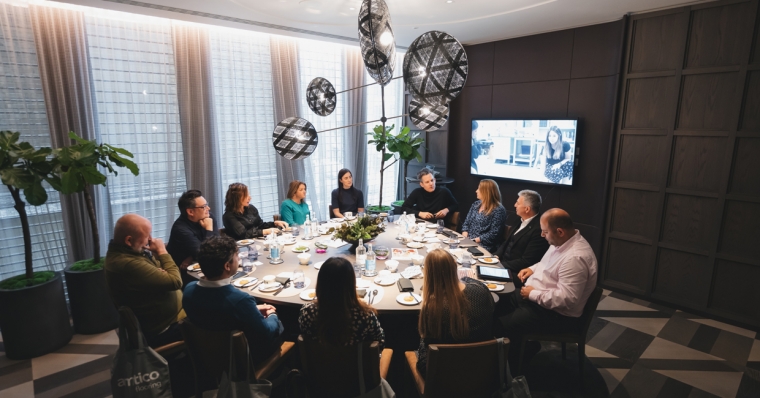
Sustainability
Responses to this final topic were particularly illuminating, and highlighted the divorce between the desire to adopt sustainable practices, and a genuine commitment to overcoming the financial and organisational challenges this poses.
“We have had projects where clients have said to us ‘we want the core of the thing you’re doing to be sustainable’ and we’ve spent a huge amount of time investigating … and it’s been a very satisfying process for us. Then, when we’ve costed it, they’re not prepared to pay for it,” said Richard McCready-Hughes. “It’s heartbreaking, because you feel you’ve cracked it to a certain extent.
“It’s like flatscreen TVs – I mean, years ago, we weren’t putting those into hotel rooms, were we? Then the cost dropped and that’s now standard. If the cost can drop, and if that work can be done by suppliers to get that price point down and make it much more viable, we might be having a very different conversation in 10 year’s time.”
“Sustainability should be thought of as an exciting thing “¦ you get to find new suppliers, you get to find new craftsmanship … it’s exciting to give your hotel that sense of context” – Tom Thorogood
“When a client wants to be sustainable, I always say, firstly, it’s going to cost you a little bit more than normal, secondly, we’ll have to be super organised if you really want to go through with it top to tail,” agreed Joey Goei-Jones. “At the same time, it’s important to understand what the property is for. If it’s a developer building it only to keep it for three years and then flip it, they’re not going to want materials that are going to last 20 years because they know someone else is going to come in and rip everything out.”
Alex Kravetz discussed sustainability from a sociological point of view. “You need to approach sustainability from the perspective of sourcing locally and keeping the labour force local if you can. Sustainability comes through communities too – it’s all about communication, innovation and keeping a positive attitude going forward.”
Tom Thorogood concurred with this emphasis on sourcing local. “Sustainability should be thought of as an exciting thing,” he said. “With international projects you get to find new suppliers, you get to find new craftsmanship … it’s exciting to give your hotel that sense of context.”
When it came to the luxury sector’s perspective on sustainability, the group felt that there was the same level of awareness and sense of responsibility.
“They have to care,” said Neil Andrew. “I think guests’ knowledge of sustainability has changed, and the next generation are much more willing to spend money on things that are sustainable.
“I think the perception of luxury within hospitality has switched – we all know it’s transferred from the object to the experience. I just don’t think people are going to have a choice in the future.”
Naturally, suppliers too are examining and evolving their practices and products with sustainability in mind. “As a company we have an overarching approach to sustainability,” Sophia Wise explained. “It’s not just about the product being sustainable – it’s about how you make it, how our factories are operating … we’re buying reneweable energy, we’re offsetting. We’re doing a lot as a company to be more sustainable, as well as working on the products themselves.”
Afterthoughts
After a thoroughly enjoyable and thought-provoking discussion, Can Faik drew the roundtable to a close with the promise of lunch by Pan Pacific London’s talented executive chef, Lorraine Sinclair.
A common thread throughout the roundtable was the importance of communication and connectivity. Building strong relationships with our colleagues, customers and the communities in which we work ultimately underlies our success, and cannot be undervalued in today’s climate.
Roundtable host Amtico is an innovative British manufacturer of luxury flooring products with more than 50 years of expertise and experience. The brand is particularly well known as a pioneer of luxury vinyl tiles (LVT), which have been made at its Coventry headquarters since 1964. Amtico’s portfolio is the preferred choice for designers, architects and developers across the globe, delivering on aesthetics and technical performance.


